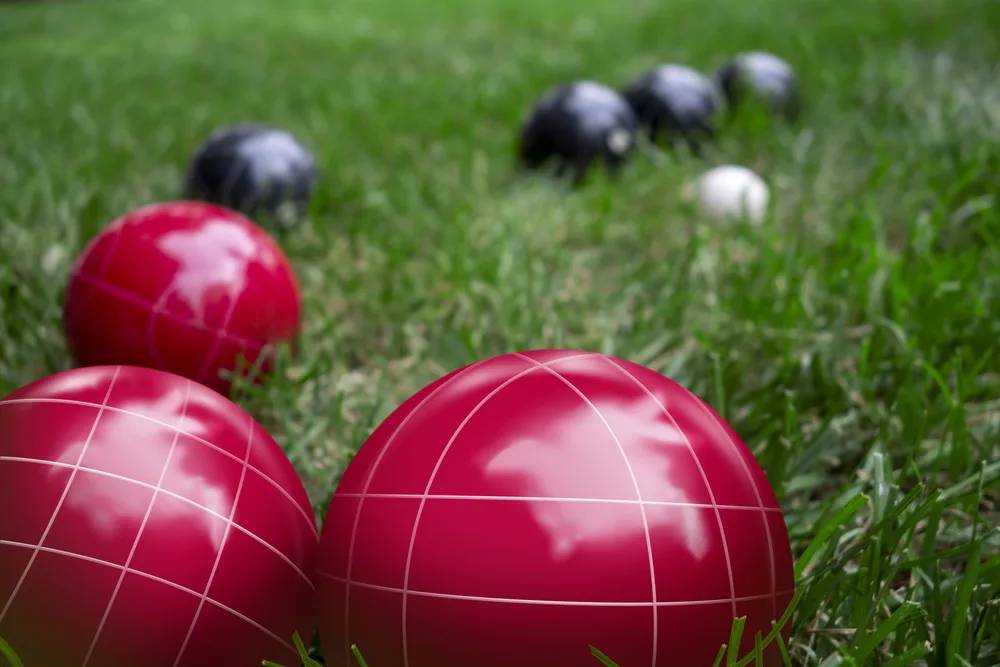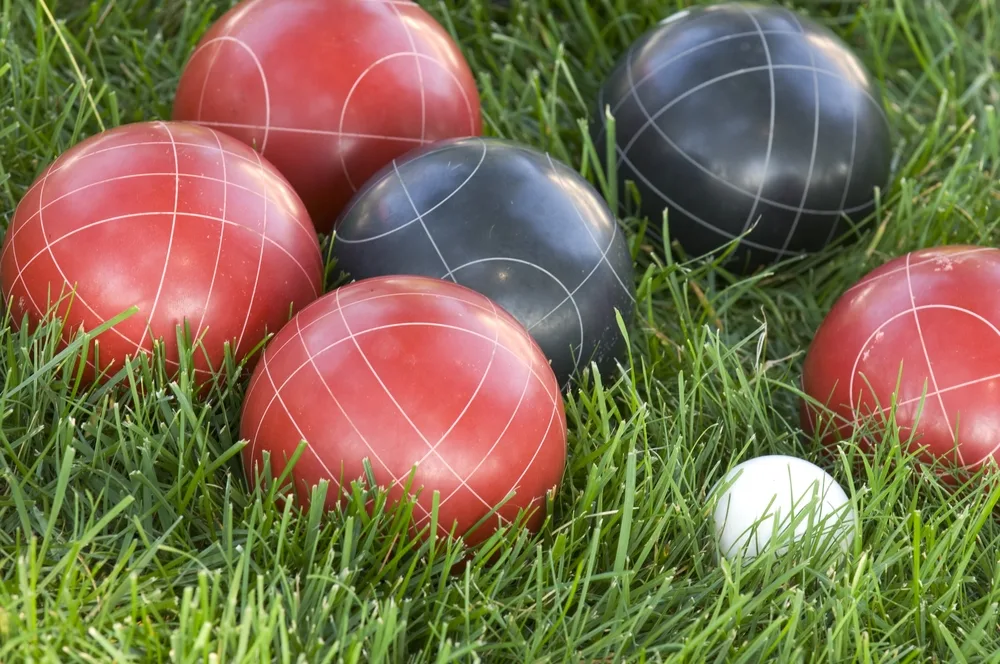
Bocce ball is a super exciting outdoor game for family and friends that involves throwing bocce balls toward a target ball (pallino). When playing the game as part of an official league or tournament, there are many rules in play.
Though you don’t have to play according to the strictest rules in your own backyard, it’s great to know about the rules so you can get the full experience of the game. In this article, we’ll share official bocce ball rules for beginners.
Contents
What Bocce Ball Is and Its Main Objective
Bocce ball is a popular outdoor game that blends skill and strategy, often enjoyed in backyards, parks, and specialized courts.
In this game, participants—either as individuals or teams—take turns throwing bocce balls. The goal is to land them as close as possible to a smaller target ball called the pallino.
The essence of the game lies in precision and tactical play, as you aim to outscore your opponents by throwing your bocce balls nearer to the pallino.
Hint: Bocce ball is not the same as lawn bowling. Read this article to learn about the differences between the two games.
How Do You Play Bocce Ball Step by Step?
Before we get into rules governing bocce ball gameplay, it’s important to understand how a typical game goes step by step. Here goes:
- Start the Game: The game kicks off with a coin toss. The winning team will throw the first ball, known as the ‘pallino’.
- Throw the Pallino: The winner of the coin toss (the first team) will have the honor of throwing the pallino onto the court. The pallino should pass the center line to count as valid.
- Throw the Bocce Balls: After throwing the pallino, the same team throws one of their bocce balls. The goal is for it to come to rest close to the pallino without touching it.
- Opponent’s Turn: Now, the other team starts throwing their bocce balls until one comes to rest in a spot closer to the target ball than the other team’s closest ball.
- Continue Bowling: Teams continue throwing their balls, alternating turns, until all balls are thrown.
- Scoring: After all balls are thrown, the team that possesses the ball closest to the pallino scores. The scoring team gets a point for every ball they’ve thrown closer to the pallino than the opposing team’s balls. Frames continue as described in steps 3 through 6.
- The End of the Game. The game isn’t over until a team reaches the pre-agreed point limit.
Bocce Ball Rules: What Are the Basic Rules of Bocce Ball?
With that information understood, let’s get into some of the most basic rules of bocce ball. Be prepared – there are quite a few rules to be mindful of, but once you get into playing the game, they’ll come to you. Let’s get into them below:
- A bocce ball should not hit the backboard unless it hits the pallino first. If it hits the backboard without touching the pallino, it’s considered to be a dead ball and will be put out of play.
- Once the first bocce ball comes to rest, a member of the opposing team takes a turn. They, of course, will try to get a ball closer to the pallino than the other team. The team will continue to throw balls until they either run out of balls or succeed in getting their ball closer to the pallino and scoring one point.
- If two bocce balls from opposing teams are equidistant from the pallino, no points will be awarded and a tie will be declared. The game will continue as it did previously to break the tie.
- There will be times when precise measuring will be needed. And that can happen at any point during the game. In official games and tournaments, the teams can call a referee or other official to determine which ball is closest to the pallino and, consequently, which team will get the point. Whenever measurements are done by players, only one player can do the measuring – all the rest of the players should remain on their side of the court.
Throwing Bocce Balls
There are a few acceptable throwing styles in bocce ball, the most common being the underhand toss. The underhand toss requires you to hold your ball with your palm upward.
You may also come across people who prefer to do an overhand toss, which may not be allowed in certain competitions and leagues. But even with overhand tosses, it’s helpful to keep your arm below your shoulder as you release the ball. Doing so will ensure that you retain adequate control.
Several things can invalidate your throw, and they include:
- Throwing the wrong color ball.
- Throwing your ball out of turn.
- Stepping over the foul line before releasing your ball.
- Throwing your ball outside of the court.

How Do You Score a Bocce Ball? Team Scoring Rules
In bocce ball, the point system revolves around how close your bocce balls get to the pallino, with the key catch being that only one team can score in each frame or round.
Once the frame is over (both teams have delivered their bocce balls), the team with the bocce ball closest to the pallino is the only one eligible to score. You may need to use a measuring tape for accuracy to determine which ball is closest.
Points are then awarded based on the number of balls that are closer to the pallino than the opponent’s nearest ball. For instance, if your team has two balls closer to the pallino than your opponent’s balls, you’d score two points for that frame.
Most often, bocce ball games last until a team reaches 12 points, but you can alter that according to your preferences prior to the start of a game.
Rules Concerning the Bocce Court Playing Surface
The bocce ball court is, of course, the surface you’ll be playing the game on. A standard bocce ball court is typically a rectangular field that measures 76 feet in length and 12 feet in width, according to the World Bocce League.
However, the US Bocce Federation, a regulation court dimensions, will be precisely 86.92 feet long by 13.12 feet wide. Although, sizes can vary depending on the level of play and available space. The court is usually made from a flat, even surface – some potential options include:
- Crushed stone
- Clay
- Carpet
- Dirt
- Oyster shells
If you’re playing on a regulation court, you’ll notice that there are both boundary lines and markers that players will use to facilitate game play. For instance, there’s a designated foul line you shouldn’t cross while delivering your bocce balls.
Rules on Players and Teams
Bocce ball is meant to be played in two teams; it’s not a solitary game. If you and a friend want to play, you can have a singles game. You can also play doubles (2 on 2), triples (3 on 3), or four on four.

Additional Bocce Rules for Beginners
Given that scoring is intimately connected to where the bocce balls are in relation to the pallino, you’ve got to be careful about moving either the bocce balls or the pallino. It’s also good to show proper etiquette in general. Here are a few rules to keep in mind:
- Non-playing team members should not be hanging out on the court. They should wait at the end of the court until their turn comes. Since this game relies heavily on concentration, it’s essential for all players to observe this rule.
- Don’t move any of the bocce balls until the frame is over. Violating this rule can result in the opposing team getting extra points or your team losing the ability to score for the frame.
- Being 15 minutes late to an official game could result in a forfeit.
Can You Hit the Side Wall in Bocce?
While playing bocce, players often wonder whether they can hit the side wall or not. In many casual backyard games, hitting the side walls may be acceptable or even part of the strategy.
However, in official bocce ball rules, the side walls are typically out of bounds. Any ball that strikes the side wall is considered a ‘dead ball’ and is immediately removed from the court for the rest of that frame.
Bocce Ball Etiquette
Like many sports, Bocce ball has its own set of etiquette that players are expected to follow. Here are some key bocce ball etiquettes:
1. Respect Your Opponents: Always show respect and sportsmanship towards your opponents. Greet them before the game and congratulate them on good shots.
2. Maintain Silence: When it’s your opponent’s turn, maintain a respectful silence. Avoid distracting or disturbing them during their play.
3. Handle Equipment Carefully: Treat the bocce balls and the court with care. Avoid forcefully throwing or dropping the balls, and handle them gently to prevent damage.
4. Be Prompt: Play promptly when it’s your turn. Keep the game moving at a reasonable pace to ensure everyone has a fair and enjoyable experience.
5. Be Honest: Adhere to the rules and be honest about the balls’ scores and positions. Cheating or misleading others is against the spirit of the game.
6. Stay Behind the Thrower: When it’s not your turn, remain behind the player who is throwing the ball. This ensures a safe and fair game.
7. Help Measure Distances: Assist in measuring distances and determining which ball is closest to the pallino (the target ball) when there’s a disagreement (if no referees are available). Be impartial and fair.
8. Avoid Distractions: Steer clear of distracting behaviors, like excessive movement or noise, especially when someone is about to throw a ball.
9. Be Gracious in Victory and Defeat: Regardless of the outcome, be gracious and courteous. Congratulate the winners and thank your opponents for the game.
By following these etiquettes, you demonstrate good sportsmanship and contribute to a pleasant and enjoyable bocce ball experience for everyone involved.
Related Articles
So, there you have it – the basic bocce rules you should familiarize yourself with. Keep in mind that there are multiple governing bodies for the sport on a local, national, and international level.
Regardless, we hope that you found all the information you were looking for, and we wish you the best as you dive deeper into the sport. And don’t forget to immerse yourself in other ball games, like traditional 10-pin bowling, no-tap bowling, and lawn bowling.
Kira Byrd, a Certified Fraud Examiner, holds a B.S. in Accounting from the University of Alabama at Birmingham. With a passion for bowling from her childhood, Kira has poured her expertise and personal experiences into creating and nurturing Bowling For Beginners. Kira’s mission is to meet new bowlers where they are and guide them toward consistently achieving higher scores. With a focus on skill development and strategic techniques, she empowers readers to take control of their game and unlock their true potential.
Bowling For Beginners embodies strict editorial integrity, ensuring reliable and unbiased information. Kira’s commitment to delivering valuable insights and practical strategies is reflected in every article. Here’s an explanation of our editorial policy and how we get money.

